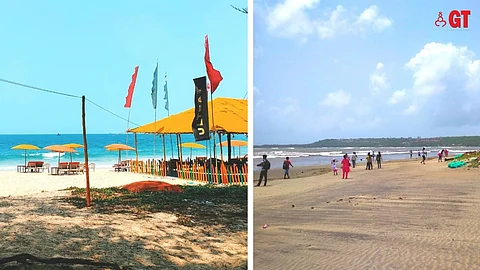

Tourists as well as locals can be seen enjoying their evening walk on the beaches of Goa, yet there are times when the experience turns unpleasant, the times when the beaches appear washed with garbage; rather, when there is more dirt than sand.
On the other hand, there are beaches that appear to be endless stretches of peace with just a few individuals – foreign as well as local – enjoying the almost infinite space without even any shacks around.
And, shacks, is the main change that has happened on beaches.
From the south to the north of Goa, it now appears that shacks are demarcated around areas where there are resorts, and hence, most shacks are patronised by clients from these hotels – the trickledown effect of the economy.
Since it is now mandatory that shacks have washrooms for their diners, and that includes showers for those who feel the need to wash themselves after a swim in the sea, shacks in Goa now appear to have that extra trimming.
Since it is now mandatory that shacks have washrooms for their diners, and that includes showers for those who feel the need to wash themselves after a swim in the sea, shacks in Goa now appear to have that extra trimming.
But, that wasn’t always the case. Initially, shacks were about enjoying a cup of tea or sipping some bottled water or chewing biscuits sold over the counter, the latter usually a table.
Primarily, to many foreigners, they were the safest places to deposit the luggage brought to the beach, as the concept of shacks in Goa began with the advent of the hippies.
In the past, locals who visited the beach, especially during the the summer vacation, would shelter from the sun and the wind against the canoes that lined the beaches.
After a swim, mothers would open tiffin boxes that contained bhaji puri, sandwiches, fruits and sweets made at home.
In the past, locals who visited the beach, especially during the the summer vacation, would shelter from the sun and the wind against the canoes that lined the beaches.
A visit to the beach, therefore, was an exercise that began at home, with family bonding being the main ingredient.
Such bonding could also be seen in shacks, in the early days, when parents and children pitched in, with time and effort, to keep the visiting guests happy with many offering mats instead of tables and chairs.
Going to the beach with a mat was a tradition that disappeared with the appearance of tables, chairs, high-end music systems and even lights at some places.
Soon, tea too was replaced by alcohol, more specifically beer, which was, back then, stored in tubs or crates with ice blocks brought from the city. Beer and soda bottles were mixed in ice that was crushed and sprayed with salt and sand to make the coolness last.
Those shacks had no showers or any source of fresh water for a wash after a swim in the sea. One just 'dried up' and if lucky, used water from a nearby well to get rid of the saltiness that wrapped the body.
If unlucky, the journey back home was a salty one!
As time passed, fish became the staple diet of most shacks, and since the number of fishermen was huge, competition was not about where one got the freshest fish, but which shack had the best variety.
The men would go out to fish and the women would stay back to clean the catch and serve it fresh to customers and many a time – when education was not compulsory – the children would do the cleaning.
Soon, tea too was replaced by alcohol, more specifically beer, which was, back then, stored in tubs or crates with ice blocks brought from the city.
Slowly, the cultural ethos of life in villages assimilated Western tones, thinking evolved differently and changes in lifestyle crept in right from what to wear or what music to listen, to the type of food, to even styles of smoking.
Bidi, the local tobacco, which lent an unforgettable smell, made space for cigarettes, and slowly, cigarette papers could be seen at kiosks along with tobacco pouches.
Everything is different now, except for a few shacks run by locals and beaches crowded with people from outside who have taken the place of most locals. This is choice we made.
A shack without an element of Goa is a structure without the foundation of the land, and this is one aspect that needs to be looked into by tourism stakeholders.
A beach without locals is like a garden without plants. It makes no sense.
We need to take another look at our act to make our guests feel comfortable and safe again.